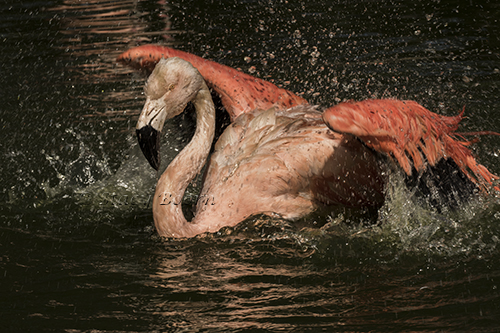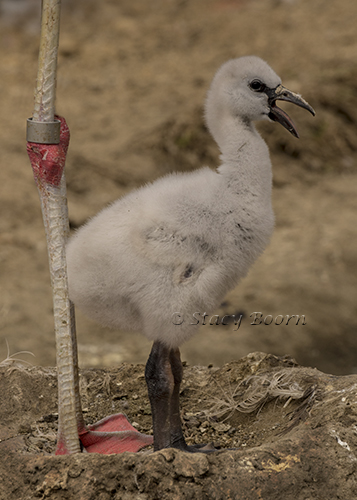
Flamingos march in salt water lagoon near Walvis Bay, Namibia
I’d like to confess to a bit of wickedness I pulled off as a 10 year old. On a balmy summer day in upstate New York I noticed that our neighbors were away on vacation. I sauntered onto their front lawn, checked the street for potential witnesses and then did the deed: I rearranged their tacky yard ornaments. Those 7 plastic pink flamingos, which they considered precious art objects, had enjoyed a prominent place in their flower beds far too long. At my command they lined up like lady soldiers at the end of their driveway.
 Truth be told, I really admired those particular polyethylene flamingos even though they were readily available at the local five and dime. For a buck you could come home with a piece of flaming pink tropical elegance that would transform your otherwise humdrum house. Obviously, these were still the pre-Woodstock days before the twenty-somethings began to appreciate and romanticize nature and scorn all things plastics and mass-produced.
Truth be told, I really admired those particular polyethylene flamingos even though they were readily available at the local five and dime. For a buck you could come home with a piece of flaming pink tropical elegance that would transform your otherwise humdrum house. Obviously, these were still the pre-Woodstock days before the twenty-somethings began to appreciate and romanticize nature and scorn all things plastics and mass-produced.
These fake birds are natives, not of Florida, but of Leominster, Massachusetts, which bills itself as the Plastics Capital of the World. Sculptor Don Featherstone was hired in 1957 by the Union Products plastics company, where his second assignment was to sculpt a pink flamingo. Since no live models were available, he copied a National Geographic photo.
 These famous pink birds, the live ones, can be found in warm, watery regions on many continents. They favor environments like estuaries and saline or alkaline lakes. Considering their appearance, flamingos are surprisingly apt swimmers, but their main habitat is on the mud flats where they breed and feed.
These famous pink birds, the live ones, can be found in warm, watery regions on many continents. They favor environments like estuaries and saline or alkaline lakes. Considering their appearance, flamingos are surprisingly apt swimmers, but their main habitat is on the mud flats where they breed and feed.
Much to my delight, I saw a colony of some thousand-plus flamingos while traveling in Namibia, at Walvis Bay.  Because we had a tight schedule, we could only take a few minutes to photograph the flamingos from the roadside. Perhaps remembering my childhood, I wanted to run among them and regroup them into new patterns, or at least steal a brief eye-to-eye encounter.

10 day old chick, San Francisco Zoo
I love the flamingos’ long, lean, curved necks and black-tipped bills with their distinctive downward bend. These bills allow them to feed on small organisms—plankton, tiny fish, fly larvae, and the like in mud flats or shallow water. They use their long legs and webbed feet to stir up the bottom, exposing their prey.
Often the flamingos bury their bills, or even their entire heads, and suck up both mud and water to access the tasty morsels within. A flamingo’s beak has a filter-like structure to remove food from the water before the liquid is expelled. Since shrimp-like crustaceans are responsible for the flamingos’ pink color, the birds grow pale in captivity unless their diet is supplemented.
This week I visited the San Francisco Zoo to see “our†nesting flamingos. A mated pair will bear only one chalky white egg each year, so I was fortunate to count five eggs and two chicks. American flamingos are monogamous birds and communal nesters, and it is not uncommon to have nests from different pairs only a few feet apart. The male and female take turns incubating the nest for 28-32 days. The parents keep the chick under them and feed it there for 3-12 days until it joins a group of other recently hatched chicks for communal care.
Each time I see these beautiful birds, I can’t help but ask the question, Will we human beings ever learn from the flamingos the art of cooperation and coexistence?

14 Lesser Flamingos among 14,000 in lagoons at Sandwich Harbor south of Walvis Bay, Namibia
